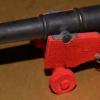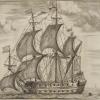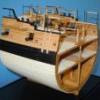-
Posts
1,763 -
Joined
-
Last visited
Reputation Activity
-
 Mark P got a reaction from mtaylor in Ratlines-What knot do you use on the ends? And how do you trim off the thread?
Mark P got a reaction from mtaylor in Ratlines-What knot do you use on the ends? And how do you trim off the thread?
Hi Keith;
I think you will find that in the days of sailing vessels a clove hitch was used where the ratlines crossed the inner shrouds, but an eye-splice was formed in each end and this was seized to the outermost shrouds.
All the best,
Mark P
-
 Mark P got a reaction from mtaylor in Royal Caroline, deck covering
Mark P got a reaction from mtaylor in Royal Caroline, deck covering
Greetings everyone;
I am researching the Royal Caroline of 1749, and as part of this I have viewed the original of the painting which is used as a frontispiece in Sergio Bellabarba's AOS book about her. As his illustration is in black and white what I will be describing is not obvious, but it is possible to view colour images of this painting for anyone really interested.
Anyway, in this painting, although parts of some of the decks are visible, no deck planking is shown. instead, the deck appears to be covered with a uniform grey-coloured something. My first, and so far only, realistic guess is that it is painted canvas. This grey covering is visible on the quarterdeck, where the Royal passengers would mostly appear, so it may be related to them, but it also appears on the forecastle, where they certainly would not normally go. The upper deck in the waist cannot be seen, but it would seem a fair assumption that it was similarly treated.
Could it be purely decorative, or could it be as a means of aiding important feet to avoid slipping and sliding as the vessel heeled and pitched.
Before I go and pass many hours wading through her log-books in an effort to see if anything about this is mentioned, I wondered if any other members here might know anything about it.
All the best,
Mark P
-
 Mark P reacted to mtaylor in Buying Replacement Belaying Pins
Mark P reacted to mtaylor in Buying Replacement Belaying Pins
And definitely stronger than wood. The thin wood ones will work but putting any stress on them is very problematical.
-
 Mark P reacted to David Lester in Buying Replacement Belaying Pins
Mark P reacted to David Lester in Buying Replacement Belaying Pins
Hi Mike,
Check out Cast Your Anchor (www.castyouranchorhobby.com) They have walnut and boxwood belaying pins in several sizes and give very precise measurements - length, diameter and length above the rail. They're really great to deal with too.
David
-
 Mark P got a reaction from EJ_L in Advice for consolidated listing of resources
Mark P got a reaction from EJ_L in Advice for consolidated listing of resources
Dear Wayne;
Such a resource as you describe would be invaluable to many modellers.
I would certainly be a visitor. The thought of constructing a model that subsequently turns out to contain errors which could have been eliminated by deeper research is not pleasant. The availability of additional resources would be most welcome.
Listing in the way you outline seems to be best to me.
I could also perhaps help in some small way, if you need anything from England. Please feel free to ask if you think of anything that may require some on-the-spot research.
All the best,
Mark P
-
 Mark P got a reaction from trippwj in Advice for consolidated listing of resources
Mark P got a reaction from trippwj in Advice for consolidated listing of resources
Dear Wayne;
Such a resource as you describe would be invaluable to many modellers.
I would certainly be a visitor. The thought of constructing a model that subsequently turns out to contain errors which could have been eliminated by deeper research is not pleasant. The availability of additional resources would be most welcome.
Listing in the way you outline seems to be best to me.
I could also perhaps help in some small way, if you need anything from England. Please feel free to ask if you think of anything that may require some on-the-spot research.
All the best,
Mark P
-
 Mark P got a reaction from donfarr in Advice for consolidated listing of resources
Mark P got a reaction from donfarr in Advice for consolidated listing of resources
Dear Wayne;
Such a resource as you describe would be invaluable to many modellers.
I would certainly be a visitor. The thought of constructing a model that subsequently turns out to contain errors which could have been eliminated by deeper research is not pleasant. The availability of additional resources would be most welcome.
Listing in the way you outline seems to be best to me.
I could also perhaps help in some small way, if you need anything from England. Please feel free to ask if you think of anything that may require some on-the-spot research.
All the best,
Mark P
-
 Mark P got a reaction from Canute in Advice for consolidated listing of resources
Mark P got a reaction from Canute in Advice for consolidated listing of resources
Dear Wayne;
Such a resource as you describe would be invaluable to many modellers.
I would certainly be a visitor. The thought of constructing a model that subsequently turns out to contain errors which could have been eliminated by deeper research is not pleasant. The availability of additional resources would be most welcome.
Listing in the way you outline seems to be best to me.
I could also perhaps help in some small way, if you need anything from England. Please feel free to ask if you think of anything that may require some on-the-spot research.
All the best,
Mark P
-
 Mark P got a reaction from flying_dutchman2 in Advice for consolidated listing of resources
Mark P got a reaction from flying_dutchman2 in Advice for consolidated listing of resources
Dear Wayne;
Such a resource as you describe would be invaluable to many modellers.
I would certainly be a visitor. The thought of constructing a model that subsequently turns out to contain errors which could have been eliminated by deeper research is not pleasant. The availability of additional resources would be most welcome.
Listing in the way you outline seems to be best to me.
I could also perhaps help in some small way, if you need anything from England. Please feel free to ask if you think of anything that may require some on-the-spot research.
All the best,
Mark P
-
 Mark P got a reaction from mtaylor in Advice for consolidated listing of resources
Mark P got a reaction from mtaylor in Advice for consolidated listing of resources
Dear Wayne;
Such a resource as you describe would be invaluable to many modellers.
I would certainly be a visitor. The thought of constructing a model that subsequently turns out to contain errors which could have been eliminated by deeper research is not pleasant. The availability of additional resources would be most welcome.
Listing in the way you outline seems to be best to me.
I could also perhaps help in some small way, if you need anything from England. Please feel free to ask if you think of anything that may require some on-the-spot research.
All the best,
Mark P
-
 Mark P got a reaction from hexnut in HMS Dragon 1760 by Siggi52 - FINISHED - Scale 1:48 - English 74-Gun ship
Mark P got a reaction from hexnut in HMS Dragon 1760 by Siggi52 - FINISHED - Scale 1:48 - English 74-Gun ship
Hi Siggi;
Thanks for posting that excerpt about the washing etc. Very interesting.
There were some very cruel captains. Piggott, of the 'Hermione,' who was so bad that his crew murdered him, was an extreme example.
On the other hand, even the Admiralty could be amenable at times. When the crews of the ships at Spithead mutinied, without violence, in 1797 (although they made it clear that if the enemy came around they would return to duty) their quite reasonable demands were agreed to. It was only later, when crews in other bases tried to extract more concessions that things turned nasty (although this seems in great part due to the character of the ringleaders)
As with so many things, I think it all comes down to the fact that there are many different types of people, and each behaves differently.
All the best,
Mark P
-
 Mark P reacted to dafi in Thinking things through: Lantern in mast top - what rules of positioning?
Mark P reacted to dafi in Thinking things through: Lantern in mast top - what rules of positioning?
Quite a while ago Blue Ensign pointed me to an interesting question. Todays Victory is carrying a lantern in the main top. Lavery points out in Arming and Fitting on page 255 that the position of the lantern follows the rank: Admiral in the main top, Vice Admiral in the fore top and Rear Admiral in the mizzen top.
As Nelson was Vice Admiral of the White at Trafalgar, the lantern should be displayed in the fore top to show the correct position at Trafalgar as indicated by Lavery.
But apart from Laverys remark I did not found any other mention of this practice, the only reference he gives is the Public Record office Adm 106/2233, 26 Jan 1804, unfortunately unknown to me. Does anybody have access to it?
But I just stumbled across another contradicting reference, again, it did not jump into my eye even though I examined the picture laready multiple times.
Painting "The 'Victory' Leaving the Channel in 1793" Monamie Swaine, http://collections.rmg.co.uk/collections/objects/15169.html BHC3696 The 'Victory' is shown broadside to port, going down Channel to windward with Rudyerd's Eddystone Lighthouse distantly visible beyond her stern. She is shown flying the flag of Lord Hood as Vice-Admiral of the Red (red at the fore), as she heads outward-bound with her squadron in 1793 for the Mediterranean, where she was Hood's flagship at the Siege of Toulon and the invasion of Corsica. Hood had been promoted to Admiral of the Blue by the time he returned in November 1794, and on the left 'Victory' is shown again, leading the return of his squadron. In the main view 'Victory' also flies a Union jack on her bowsprit and a red ensign, as do other ships of the outward-bound squadron following her. The 'Victory' was floated out of dock at Chatham in 1765 and the picture shows her as built except that she has been coppered. This process first took place in March 1780, when the bottom of the ship below the waterline was sheathed with 3923 sheets of copper to protect her hull against ship-worm. The name 'Victory' is present on the stern. In 1797she was Sir John Jervis's flagship at the Battle of Cape St Vincent and in 1801-03 had a major rebuild at Chatham that enclosed her stern galleries and gave her a new figurehead. She then went to the Mediterranean as Nelson's flagship, up to and including at the Battle of Trafalgar in 1805. Monamy was the son of the better-known Francis Swaine and grandson of the even more famous Peter Monamy, after whom he was named. He was active from about 1769 to 1774 and, if this painting is by him, into the 1790s. As an artist he specialized in still-life and genre, although he exhibited two marine pictures at the Free Society of Artists in 1771 and 1772. Date made circa 1795 Even though Hood was Vice Admiral - correctly displayed with the flag on the fore mast - the lantern is on the main top: That leads me to the question: Does anybody have more information about the regulations of putting the mast top lanterns? Cheers and thanks, Daniel -
 Mark P got a reaction from Canute in Greenwich Hospital barge of 1832 by druxey - FINISHED - 1:48 scale
Mark P got a reaction from Canute in Greenwich Hospital barge of 1832 by druxey - FINISHED - 1:48 scale
Hi Druxey;
I'm with everyone else on this. A fine inspiration to all, and a very informative, instructive and pleasure-to-read build log, with a lovely model at the end of the trail!
All the best, and many thanks for taking the trouble to share this.
Mark P
-
 Mark P got a reaction from dvm27 in Caroline's bottom
Mark P got a reaction from dvm27 in Caroline's bottom
Hi Grant;
'White stuff' was used to cover the ship's hull below the waterline. It was intended for use in the tropics, where the shipworms were more active. It was more expensive than the 'black stuff' which was used for ships in European waters. However, most models depict the ships with a white bottom, as it is much more attractive.
In the case of the Royal Caroline, she is shown in several paintings by John Cleveley the Elder, and where her underwater hull is visible, it is white. As Cleveley was renowned for the accuracy of his paintings (also, he was a former shipwright at Deptford Dockyard, and was there at the time that Royal Caroline was built there) I would take that as sufficient authority to paint her bottom white.
As for coppering, this was only introduced widely in the early 1780s, so would not have been used at the time of Royal Caroline's launch or for much of her career (not until after she was re-named the Royal Charlotte in 1761)
All the best,
Mark P
-
 Mark P reacted to druxey in Caroline's bottom
Mark P reacted to druxey in Caroline's bottom
Interesting possibility for 'pease'/'petit pois'. The reference I came across was dated July, 1753. "...a pease Coat bottom upon her, which will last very well until Spring." This was for a small sloop. The reference to spring suggests something less permanent than copper nails, though.
-
 Mark P reacted to ofencer29350 in Caroline's bottom
Mark P reacted to ofencer29350 in Caroline's bottom
the white color you call is in reality the "espalme"
the composition is:
8 brai - 3 soufre - 1 suif
Obliged of warmed to melt the pitch and the tallow, and also to obtain a smooth mixture with the sulfur which does not incorporate so easily.
picture of brai:
picture of the mixture:
-
 Mark P got a reaction from robin b in Caroline's bottom
Mark P got a reaction from robin b in Caroline's bottom
Hi John;
That sounds to me like a very reasonable theory. I have read about the method of protecting the ship's bottom by hammering in thousands of copper nails so close together that the heads overlapped, They would indeed have looked like peas once they turned green.
In the Royal Navy, pea soup was a popular meal, so there may well have been only a short distance between seeing the effect on the ship's bottom and naming it after a common food.
All the best,
Mark P
-
 Mark P got a reaction from mtaylor in Caroline's bottom
Mark P got a reaction from mtaylor in Caroline's bottom
Hi John;
That sounds to me like a very reasonable theory. I have read about the method of protecting the ship's bottom by hammering in thousands of copper nails so close together that the heads overlapped, They would indeed have looked like peas once they turned green.
In the Royal Navy, pea soup was a popular meal, so there may well have been only a short distance between seeing the effect on the ship's bottom and naming it after a common food.
All the best,
Mark P
-
 Mark P reacted to Jim Lad in Any difference between a 'riffler' file and a 'needle' file?
Mark P reacted to Jim Lad in Any difference between a 'riffler' file and a 'needle' file?
Yes, 'rifflers' have curved ends and are very handy for getting into really tight corners. Generally speaking, the files that you buy from a jewellery supply house are much higher quality that hobby shop files, but will cost you a lot more money.
John
-
 Mark P reacted to GuntherMT in Any difference between a 'riffler' file and a 'needle' file?
Mark P reacted to GuntherMT in Any difference between a 'riffler' file and a 'needle' file?
And in my opinion, having used both, they are worth every penny.
-
 Mark P reacted to exwafoo in Any difference between a 'riffler' file and a 'needle' file?
Mark P reacted to exwafoo in Any difference between a 'riffler' file and a 'needle' file?
Search on 'Escapement File' for small precision files. Most definitely not cheap and on my wish list.
Best
Al
-
 Mark P reacted to JohnE in Caroline's bottom
Mark P reacted to JohnE in Caroline's bottom
I knew a Caroline once and ... um ... sorry.
From 1650 to 1730, various desultory experiments were made with sheathing techniques and materials, including planking arrayed with copper studs. After the ship launched, it didn’t take long for the copper to turn green. The French called the overall effect ‘petit pois’. I can see the English calling it pease. Have no clue whether this is the ‘pease’ bottom Druxey speaks of. It’s just that the name caught my attention and got me going.
Masseille, H. Notes sur la sallsure et les procédés d'entretien des carènes Immergées. Peintures Pigments Vernis, Vincennes, 1933.
John
-
 Mark P reacted to GrantGoodale in Caroline's bottom
Mark P reacted to GrantGoodale in Caroline's bottom
Many thanks for all this information. Great stuff!
-
 Mark P got a reaction from mtaylor in Greenwich Hospital barge of 1832 by druxey - FINISHED - 1:48 scale
Mark P got a reaction from mtaylor in Greenwich Hospital barge of 1832 by druxey - FINISHED - 1:48 scale
Hi Druxey;
I'm with everyone else on this. A fine inspiration to all, and a very informative, instructive and pleasure-to-read build log, with a lovely model at the end of the trail!
All the best, and many thanks for taking the trouble to share this.
Mark P
-
 Mark P got a reaction from mtaylor in Caroline's bottom
Mark P got a reaction from mtaylor in Caroline's bottom
Hi Druxey;
I have never heard of that one. I will keep an eye out for any references in the future.
All the best,
Mark P









